Monster Times
Monster Times was a newspaper-format publication, one of many horror and fantasy themed titles of the time influenced by Forrest Ackerman's Famous Monsters of Filmland. It ran from 1972 to 1976. This was issue number 47, May 1976, with oddly coloured Gray Morrow art of Landau, Bain and Morse.
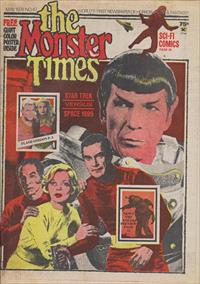
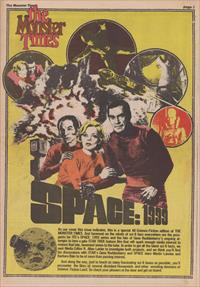
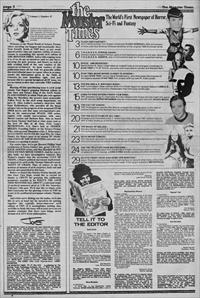

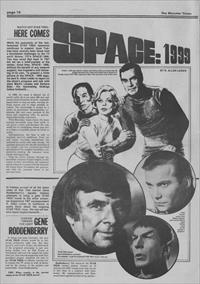
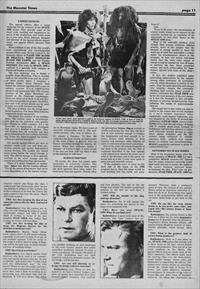

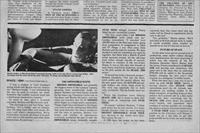
By R. Allen Leider
While the popularity of the late, lamented Star Trek teleseries continues to expand, loyal Trekkies have recently been faced with a formidable challenger to the TV sci-fi throne, ITC's Space: 1999. You may recall that back in TMT #41 we ran a brief preview of the series; since then, Space: 1999, without the benefit of any network support, has inspired a cult following of its own. To present a fuller picture of the Space: 1999 saga, we sent R. Allen Leider to report on the show's progress and talk with stars Martin Landau and Barbara Bain. His fascinating findings follow forthwith...
In 1999, the moon is blasted out of earth's orbit. On it are some 300 men and women from all nations of earth, originally based there to man an early warning defence system and to repel possible invaders. The catastrophe is caused by a series of spectacular thermonuclear explosions that tear away portions of the moon and completely alter its gravitational relationship with earth.
With Moonbase Alpha intact, the moon careens inexorably away from earth. It can never return, and becomes the only world for its inhabitants, whose goal now is to find a compatible planet on which to settle.
Self-sustaining, the base is able to maintain survival conditions. Food, air and water recycling installations are powered by atomic and solar energy. All systems necessary for the life functions of the people and the computer-governed operations of the complex machinery, are operative - making the runaway moon totally self-supporting.
Thus the fateful journey through the incredible vastness of space begins. In the course of their adventures, the explorers match wits and weapons with the fantastic life forms found throughout the galaxies, and with the awesome forces of the universe itself.
The special effects offer. a major challenge for the creators of the Space: 1999 series. They provide some of the most vivid, exciting and imaginative aspects of the production, and credit must go to two men, Brian Johnson, designer and director of the special effects department, and special effects director Nick Alider.
Brian Johnson is one of the film world's most experienced and knowledgeable special effects men. He has worked on the fantastic effects in Taste The Blood Of Dracula, When Dinosaurs Ruled The Earth, and the Stanley Kubrick blockbuster 2001: A Space Odyssey. His work for Space: 1999 is confined to a specially built complex at Pinewood Studios in London. [Actually Johnson and the effects unit were based at Bray Studios, not Pinewood]
"My first challenge was to design a feasible Alpha Moonbase. That is, feasible both on the scientific front and the practical front...studio space. I designed a modular Alpha," states Johnson, "and linked the sections together with a sort of subway system. It's a combination elevator and pneumatic tube. The scenery sections of the Alpha Moonbase are housed at the Pinewood soundstages. There are about 18 of them in all and they are interchangeable for greater flexibility. One wall with certain details can be used in many sets with minimal restyling." [The modular sets were designed by Keith Wilson, although Johnson worked closely with him in the initial modular concepts and designs]
The next problem was the actual space travel sequences. For these Brian Johnson created the Eagle spacecraft. "The Eagle was another of my modular ideas. The central cabin is interchangeable and can be switched with passenger, freight or other modules. It's a bit insect-like in appearance. It developed that way as I doodled it together. They (the Eagles) take off vertically and then move forward with rear rockets functioning. Some are laser-equipped for battle, others are just for transport."
The special optical effects pre shot at another studio with rear and front projection screens and special high-pattern optical devices. The models are tested many times before the actual footage is shot. The effects footage is then optically married to the other footage and the results are nothing less than spectacular. [There is no front projection, some back projection, but mostly used for live action studio screens. There is some optical printing, mainly for lasers. Oddly the main technique for effects, multiple exposures, is not mentioned]
"There is a great emphasis on technology," Space star Martin Landau affirms. "One of the pieces of hardware that we're most dependent on is the master computer on Moonbase Alpha. We have a sort of love-hate relationship with it. The technician-scientist who runs it, adores it... it's almost romance. To him, the computer can do no wrong. As commander of the base, I have to depend more on human emotional factor»for making decisions. When that computer makes a mistake - or I think it does - I want to kick it the way you kick your car when it dies on the freeway at rush hour."
Of course, the show has raised some eyebrows in scientific circles. The technical data and premises from which the show operates have come under fire from more than one quarter. Shortly after the prestigious Science Digest see here printed an article expressing the view that the show was at once fantastic enough to intrigue the imagination and real enough to be scary, letters came pouring in from experts and amateurs alike offering all sorts of criticisms of the show's premises. One of the most oft-attacked aspects of the show is the premise that the kind of explosion described in the first episode could indeed have blasted the moon out of orbit in the direction and at the speed the series tells us it did. Critics were quick to point out such scientific errors:
"If the explosion were to occur on the dark side of the moon, as the 1999 program has it, then the moon would be sent hurtling into the earth, not away from it."
And:
"Even in 24 years, the accumulation of atomic waste would never amount to the quantity needed for an explosion of the magnitude of that blast shown in the Space: 1999 show." [Neither is a credible scientific criticism, of which many could be cited]
Most of the scientific scholars, even though their precise criticisms differed greatly, were of the opinion that the amount of energy needed to blast the moon out of orbit was impossible to create under the circumstances shown in the program. In fact, one astute individual stated that the sun's total output of energy would be needed for over 40 hours to perform the feat. Even renowned science and sci-fi writer-editor Dr. Isaac Asimov agreed with most of the show's critics. see here
In fact, Dr. Asimov published some interesting observations on the subject. Among other criticisms, he questioned why the Alpha Moonbase is always lit the same, from the same direction and always very brightly, despite the constantly changing light sources (stars) around it. Asimov concluded that Star Trek was by far the more accurate of the two shows, as it had the foresight to hire scientific advisers to prevent misinformation from polluting the minds of impressionable viewers.
The simple fact is that when you deal in reality to the extent that events depicted in a sci-fi format represent what supposedly could happen tomorrow, you are trapped by the limits of present-day technology. In Star Trek, creator Gene Roddenberry had the advantage of being able to assume great leaps forward in technology and was thus allowed to utilize such otherwise fanciful devices as warp drive, phaser weaponry and the like without being subjected to vitriolic rebuttals. Still, conflicts over science fiction vs. science fact notwithstanding, Space's popularity continues to grow at a phenomenal rate.
Most of the headaches began after the initial episodes of Space: 1999 had been completed. Space creators ITC figured that the major American networks would fight tooth and nail to secure the rights to the series. Instead, network brass ho-hummed the idea. Why? Like its predecessor, Star Trek, Space: 1999 had a peculiarity that the network mentality doesn't like: It was different. Network minds like lookalikes...detective series, westerns, medical shows, etc. They are afraid of imagination, creative writing and the like because it might not appeal to people who buy the sponsors' products. They want to sell toothpaste, not quality entertainment.
"As we all could have predicted," Landau remarks, "when the series was sold to individual stations across the country, it sold like hotcakes. The ratings showed it to be miles ahead of anything else in that time slot, including all network programs."
In fact, the show has been so successful running exclusively on independent stations (over 150 at last count) that ITC is preparing a second season of 24 more episodes for the series. Presumably they based their decision on the fact that Space is wiping out all competition in two major markets, New York and Chicago. Just what the network execs in New York are doing about it is not known. It is known that producing and distributing the show cost International Television Corporation over $6 1/2 million- the most expensive TV series ever created. They spared nothing to make sure the series was the finest money could buy.
"One thing that impresses me," comments Landau, "is the use of exterior and interior sets. In most series, many of the sets are used over and over again. for 1999, they built each exterior and alien planet set from scratch so it would be a new and different place each time, not a gathering of rearranged fibreglass rocks and such. The interiors too were often changed and only main areas of activity appear frequently, for continuity."
The series is produced by the same British-based concern that had previously produced such successful series as My Partner The Ghost, The Saint The Protectors, Department S and the not-so-successful U.F.O. And ITC is very happy with its new gold-mine. After U.F.O. bombed, they went looking for ways to use the sets and crews in a new sci-fi project, and Space: 1999 was the result of that search. Both series utilize the same well-designed futuristic moonbase, laser guns and high-fashion uniforms. Only for Space: 1999, more than a few bucks went to Rudi Gernreich for the designs, which may become commercially available should the series catch on to the extent that Star Trek has. Unlike Star Trek, Space makes no pretence of being philosophy disguised as science fiction, Space: 1999 is pure futuristic gadgetry, fantasy, and adventure, with an occasional monster or two tossed in for good measure. It also sports some very talented guest stars, like Christopher Lee, Peter Cushing and Richard Johnson, to cite a few of the better-known.
"One of the best things about Space: 1999 that Star Trek didn't have is a sense of immediacy," Martin Landau opines. "Our series is just 25 years or so away. Star Trek was hundreds of years in the future...very hard to comprehend in a real sense...and very idealistic, which is fine for what it is. But I like relevancy better. The man I play might be one of the kids watching. He grew up in the fifties and knows everything they know. He may even have watched Star Trek, but he's more real to the viewer. He's very vulnerable too. The problem with the Star Trek attitude is that they could afford to be nice to everyone they met; they had this gigantic ship and enough fire power to destroy whole planets. We don't. We are a small force at the mercy of the elements and all we encounter. A very real situation that people really connect with." Like many actors who became successful in films and TV, Martin Landau didn't begin his career with any theatrical ambitions at all. Like Robert Redford and Gene Hackman, he began as a graphic artist.
"1 was always talented with paints and things," he relates. "It led me to study art at New York's Pratt Institute, the same place that Robert Redford studied. From there I went to the Art Students League and finally got my first real job as staff artist in the New York Daily News art department."
It didn't take long, however, for the acting bug to bite.
"I had always been interested in it (acting), but not as a career. My first real acting experience was in summer stock. I was so bad that I decided to attend acting classes full time."
It was in one of his classes that he,first met a pert and pretty model named" Barbara Bain.
"I was a student in Curt Conway's acting school and Martin was my instructor," Barbara recalls. "I was infuriated by the way he used to criticize my work. Somehow that conflict resolved itself into a much-more constructive emotion.' So much so that, after a 15-month courtship, Barbara and Martin were wed. "The marriage is a real 'fun' thing," says Barbara. "It's a 'hobby' sort of relationship. We enjoy each other very much. We enjoy each other's companionship. We're homebodies, we never get bored with each other and we still surprise each other from time to time. It's pure joy."
Mission Impossible was probably the biggest boost to the Landaus' careers, granting them considerable" media exposure. Barbara won three Emmy Awards for her super-spy Cinnamon Carter role on the show, and Martin did pretty well too, when you consider that his 80 Mission stints began as a single guest appearance. Things might have continued in this happy vein were it not for contractual difficulties that arose between the show's producers and the stars in question. Hassles over money and number of appearances eventually prompted the pair to split the Impossible- scene. Ironically enough, Star Trek refugee Leonard Nimoy filled the slot vacated by Landau. "The first years after I left Mission Impossible were touch and go," Landau remembers.
"I travelled over 100,000 miles in the first year alone, going from assignment to assignment in films and TV things. I was often away from Barbara and the kids for months. We then decided to look for something we could do together, but there was a dearth of good script material around. All the offerings were either cheapie rip-offs of successful shows or remakes of old, out-of-date things. It was at this time that friends of ours, Gerry and Sylvia Anderson, brought us the first outline for the Space: 1999 series. "
"It turned out to be a fantastic project," Barbara interjects. "Not just the Gernreich outfits and the special effects, but the cast, guest stars, the $270,000-per-episode budget...the whole thing awed us. The crew especially fun to work with...no friction. The tea breaks were fun too. "
When the Landaus were filming Space: 1999, did it occur to them that they would he competing with Star Trek?
"Of course," answers Barbara. "I think each series has its own merits. It's funny though, because when we were shooting Mission Impossible, Star Trek was shooting in the studio next door. That's irony for you."
If CBS buys the series, as Alas been rumoured, does that mean more new episodes will be filmed to supplement the 24 now in the can?
"Yes, probably," Martin opines. "We'll trot back to Britain and get back to Alpha. It would probably mean another six months or so, but it's fun and we love it."
As the show went into its second year of production, some rather radical changes were implemented, the most surprising of which was the removal of the Dr. Bergman character (Barry Morse) from the series [Professor, not Doctor]. Future instalments of Space: 1999 will develop new characters. One good turn is the news that an additional $700,000 will be added to the 24-episode budget, bringing the next year's total expense to a whopping 7.2 million bucks. While the show has a long way to go to catch up with Star Trek, there's a strong chance that Space: 1999 conventions aren't far off. Already, merchandisers are pushing models of the Eagle transport, everything from an inexpensive do-it-yourself job to a $14 metal model that does everything but fly. Space: 1999 comic books are printed every -month, and paperback novel versions of various episodes are crowding the shelves of many American bookstores..
If Star Trek wants to maintain its position on the American sci-fi throne, it might not be a bad idea to get that proposed ST movie in the can sans further delay.
Interview by R. Allen Leider
TMT: Have you seen Space: 1999? What do you think of it?
Roddenberry: I agree with most of the criticisms that Isaac Asimov has expressed. However, from a producer's point of view, the success of any science- fiction series on American television is a blow for all of us. Everything that opens eyes at the programming offices and advertisers' desks helps us get back on the air.
TMT: Do you like the term science fiction or do you prefer some other, non-typed title - like science drama or futuristic drama?
Roddenberry: No, science fiction is fine with me. I often use the term imaginative drama too. It depends what the project is. Imaginative drama includes fantasy, and science fiction should be realistic or scientifically plausible, which fantasy often isn't.
TMT: What is the greatest fault of science-fiction producers?
Roddenberry: Well, as I was about to say, Space: 1999 makes this mistake and so have many of the best science-fiction writers and producers: They put all or too much emphasis on the effects. The special-effects men are really most of the film's substance. The effects really have the starring roles over the three-dimensional human beings, Whose roles are diminished to supporting the effects. You cannot treat science fiction as something outside .the normal field of drama. It is drama, just under different, futuristic circumstances. It responds to the rules of drama like any other form of dramatic endeavour. So, often the characters in Space: 1999 and other shows come off as two-dimensional entities, not because the actors aren't good-many are excellent- but because the script isn't featuring them, but the opticals.
TMT: The new shows will develop the characters more, we hear.
Roddenberry: Yes, the second season, I hope so.